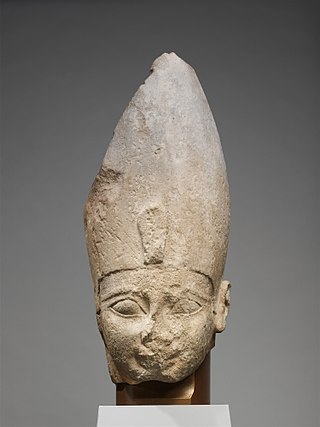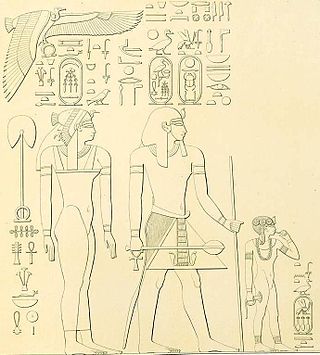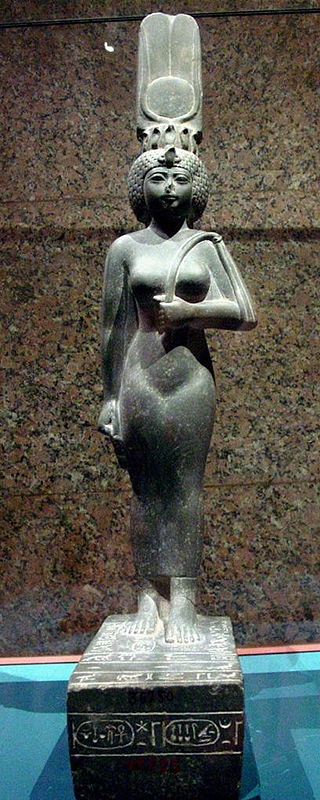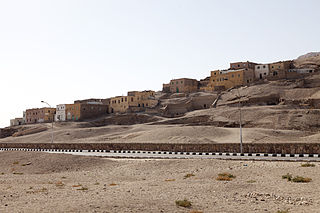Related Research Articles

Ahmose I was a pharaoh and founder of the Eighteenth Dynasty of Egypt in the New Kingdom of Egypt, the era in which ancient Egypt achieved the peak of its power. His reign is usually dated to the mid-16th century BC at the beginning of the Late Bronze Age.
Amenhotep is an ancient Egyptian name. Its Greek version is Amenophis (Ἀμένωφις). Its notable bearers were:
Thutmose is an anglicization of the ancient Egyptian personal name dhwty-ms, usually translated as "Born of the god Thoth".

Ahmose was an Ancient Egyptian queen in the Eighteenth Dynasty. She was the Great Royal Wife of the dynasty's third pharaoh, Thutmose I, and the mother of the queen and pharaoh Hatshepsut. Her name means "Born of the Moon".

Thutmose I was the third pharaoh of the 18th Dynasty of Egypt. He received the throne after the death of the previous king, Amenhotep I. During his reign, he campaigned deep into the Levant and Nubia, pushing the borders of Egypt farther than ever before in each region. He also built many temples in Egypt, and a tomb for himself in the Valley of the Kings; he is the first king confirmed to have done this.

Amenhotep I or Amenophis I, was the second Pharaoh of the 18th Dynasty of Egypt. His reign is generally dated from 1526 to 1506 BC.

Ahmose-Nefertari was the first Great Royal Wife of the 18th Dynasty of Ancient Egypt. She was a daughter of Seqenenre Tao and Ahhotep I, and royal sister and wife to Ahmose I. Her son Amenhotep I became pharaoh and she may have served as his regent when he was young. Ahmose-Nefertari was deified after her death.

Piankh was a High Priest of Amun during the 21st Dynasty.

God's Wife of Amun was the highest-ranking priestess of the Amun cult, an important religious institution in ancient Egypt. The cult was centered in Thebes in Upper Egypt during the Twenty-fifth and Twenty-sixth dynasties. The office had political importance as well as religious, since the two were closely related in ancient Egypt.

The necropolis of Draʻ Abu el-Naga' is located on the West Bank of the Nile at Thebes, Egypt, just by the entrance of the dry bay that leads up to Deir el-Bahari and north of the necropolis of el-Assasif. The necropolis is located near the Valley of the Kings.

Ahhotep II was an ancient Egyptian queen, and likely the Great Royal Wife of Pharaoh Kamose.

Pinehesy, Panehesy or Panehasy, depending on the transliteration, was Viceroy of Kush during the reign of Ramesses XI, the last king of the Egyptian 20th Dynasty.

Qurnet Murai is a necropolis located on the West Bank of the Nile at Thebes, Egypt, just to the south of Sheikh Abd el-Qurna.
Amenemope, also Amenemopet, Amenemipet or Amunemopet(ỉmn-m-ỉp3.t, Greek: αμενωφις; “Amun in Luxor”) is an Ancient Egyptian name. Its notable bearers were:
Ahmose called Turo was Viceroy of Kush under Amenhotep I and Thutmose I.

Merymose, also Mermose or Merimes, was a Viceroy of Kush under Amenhotep III. He served for almost the entire four decades of that reign.

Amenemopet served as Viceroy of Kush during the reign of Seti I.

The Eighteenth Dynasty of Egypt is classified as the first dynasty of the New Kingdom of Egypt, the era in which ancient Egypt achieved the peak of its power. The Eighteenth Dynasty spanned the period from 1550/1549 to 1292 BC. This dynasty is also known as the Thutmoside Dynasty) for the four pharaohs named Thutmose.
This page list topics related to ancient Egypt.

Taemwadjsy was an Ancient Egyptian woman living at the end of the 18th Dynasty.